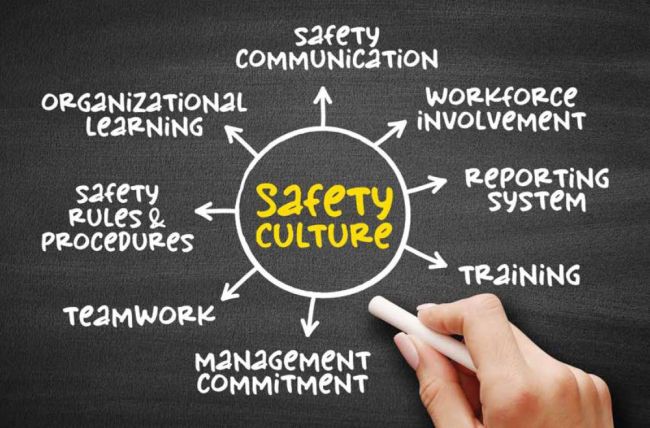
Cultivating a Healthy Fleet Safety Culture
An ideal utility fleet safety program will account for fleet’s distinct operating environment.
Why?
“The fleet group is totally different than what a lot of utility workforces do,” explained Matt Gilliland, director of operations support and business continuity for Nebraska Public Power District (NPPD). “We work on a variety of different equipment, and it’s very seldom the same issue or problem twice. Things like body positioning, tooling, and indoor and outdoor weather are unique to the fleet experience.”
From the Top Down
A safety culture reflects the shared values, beliefs, attitudes and behaviors that shape how a group approaches health and safety. The most ideal safety programs start from the top down and ensure that employee health and safety are the top priority in every decision and action taken.
According to Mark Booker, safety engineer and transportation manager for Nashville Electric Service, “Effective safety involves building and sustaining a workplace environment where safety is prioritized by leadership, and so we invest in workplace safety by aligning our safety industry with our CEO’s vision for a safe workplace.”
Shaping a safety culture requires leadership to communicate ownership and expectations to staff. Ultimately, each employee must take ownership of their personal safety, even if the utility has a safety department or a safety representative for each department.
“There could be a safety department, but they only guide and suggest and provide some tooling and equipment,” Gilliland said. “Everybody has to own their own safety and the safety of everybody around them.”
Employees working safely even when no one is watching is an indicator of a robust safety culture, noted Richard Bleser, fleet specialty practice leader at Marsh McLennan, a risk management consultancy.
“A safety culture is engaged in safety, not thinking about safety,” he said. “A great culture just does safety without thinking about it.”
Injury Prevention
Safety program performance depends in part on what the culture – and management – will accept.
“We have a mindset that all safety events and all injuries are preventable,” Gilliland said.
At NPPD, key prevention practices include pre-trip inspections, regular safety meetings and a red-tag policy to indicate equipment must not be operated. Among the metrics tracked are personal injuries, vehicle accidents and the number of days worked safely.
Daily pre-job briefings set the tone for the work ahead and offer an environment in which staff can identify potential challenges.
“That is really a crucial step we try to embed in our work, and we have caught some scenarios that would have been traps for us otherwise,” Gilliland said. For example, “There are different hand signals for forklift operators and crane operators, and we had to work out which signals we were using in one circumstance.”
In utility organizations with a healthy safety culture, employees are encouraged to ask questions about their assigned tasks and spend the necessary time preparing to execute them. This could mean anything from donning required personal protective equipment to exercising stop-work authority.
“When you build the mindset that just about anything can merit a timeout to reduce risk, it can be a game-changing move for your company,” explained Tom Karnowski, vice president of environment, health and safety for USIC, which operates a 14,000-vehicle fleet for utility location services.
One Assignment at a Time
Utility fleet departments typically track personal injuries, days away from work, and preventable and unpreventable accidents. However, NPPD has had success with a single-minded emphasis on days worked safely.
It’s a positive spin on the “X days since our last injury” sign seen in some workplaces. The fleet team focuses on completing each assignment without incurring injury.
“We stack those days up, and that leads to a series of days that leads to a series of weeks and beyond,” Gilliland said. “We’ve had one of the safest years on record since we changed our focus.”
About the Author: Gary L. Wollenhaupt is a Colorado Springs-based freelance writer who covers the transportation, energy and technology sectors for a variety of publications and companies.
*****
Sidebar: 10 Tips for Developing a Robust Safety Culture
1. Align fleet safety with corporate goals. Ensure departmental safety priorities match up with overall corporate safety objectives.
2. Promote leadership commitment. Each day, management must visibly demonstrate their buy-in by putting employee and public safety above all else.
3. Encourage employee engagement. Gently urge fleet personnel’s active participation in organizational safety meetings and preventive education sessions.
4. Build open communication channels. Develop in-person and online spaces that enable psychologically safe conversations between management and staff. Create an environment in which employees feel heard, respected, and empowered to voice concerns and suggestions.
5. Document and communicate expectations. Keep written records of work practices and procedures, safety protocols and behavioral expectations. Share and discuss them regularly to help ensure long-term consistency.
6. Identify and address unique hazards. Adapt safety programs and training to meet any specific requirements or challenges posed by utility fleet operations.
7. Monitor safety performance. Track and analyze incidents, injuries, days worked safely and other relevant metrics to guide continuous improvement.
8. Implement employee accountability measures. Embed safety expectations into performance appraisals. Recognize and positively reinforce individual and team safety contributions.
9. Invest in technology. Research and adopt health and safety management platforms and apps to help you automate inspections, tracking and reporting, improving consistency and visibility.
10. Reinforce safety ownership. Educate and empower every employee to take responsibility for their personal safety and the safety of those around them.

